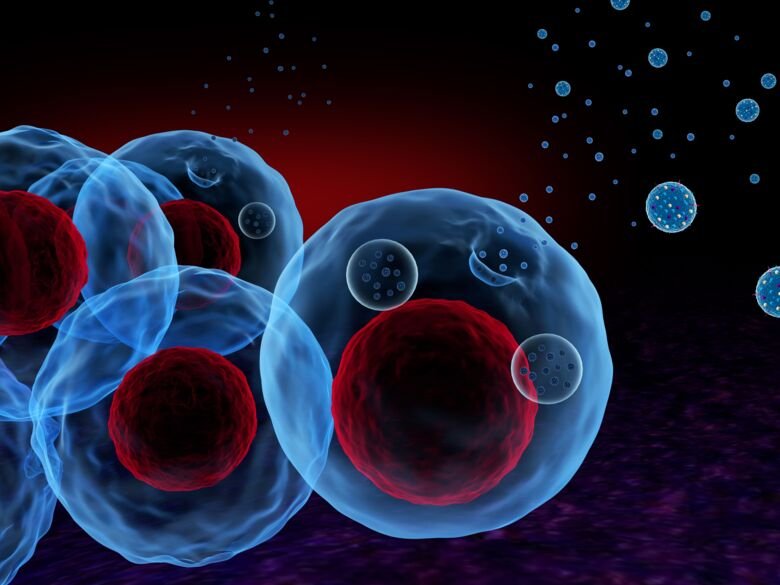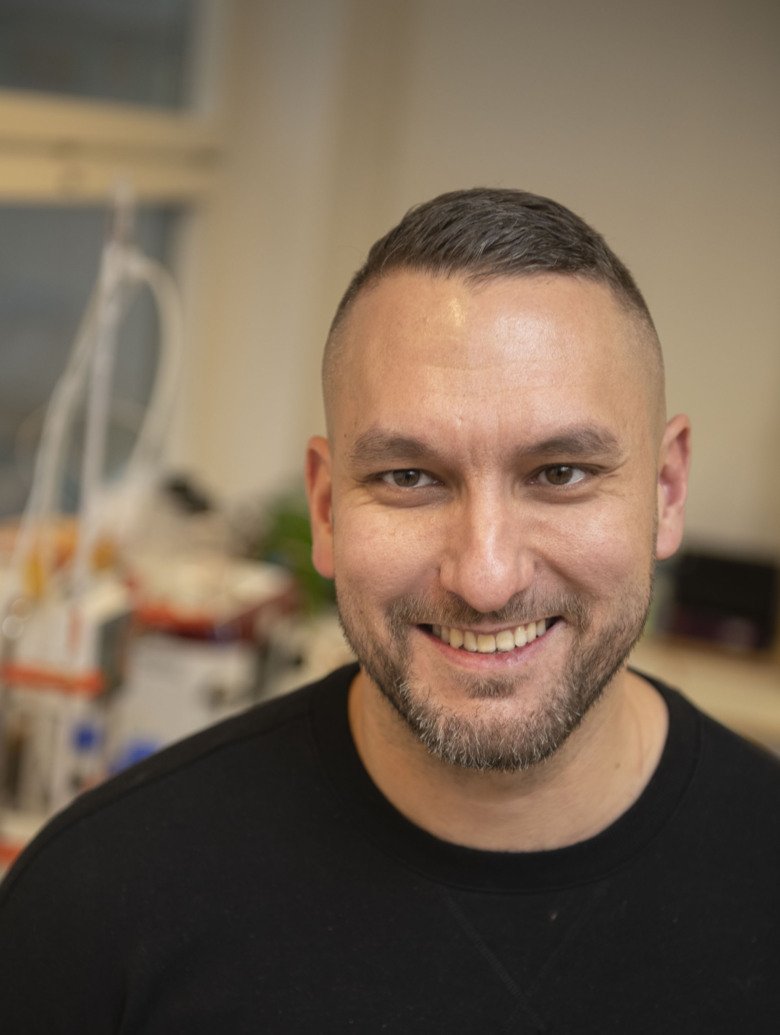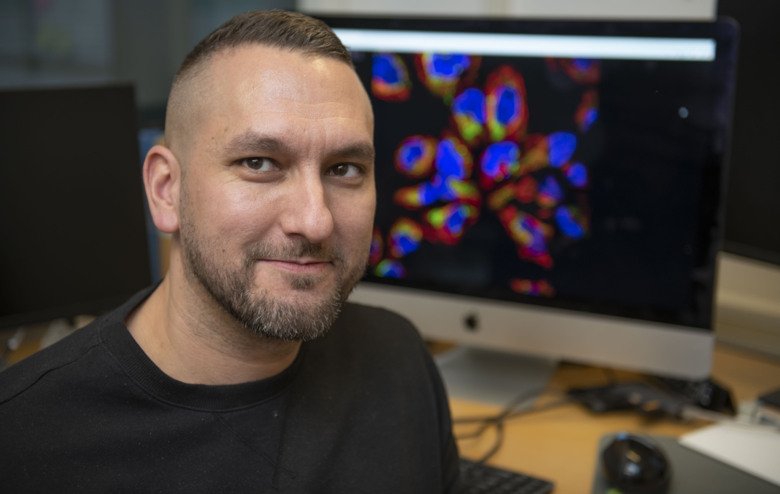High hopes for small bubbles
Exosomes are tiny bubbles that act as an advanced communication pathway between cells. However, they can also be used for treatment and are used in a variety of different areas.
Text: Fredrik Hedlund, first published in Swedish in the magazine Medicinsk Vetenskap no 1/2021.
From being regarded as cellular waste when they were first discovered in the 1980s, exosomes have for the past 5-10 years become a hot field of research. It involves small spheres of approximately100 nanometres that are excreted from the cells.

"We tend to describe them as small membrane bubbles that are dispatched out of the cell. They are like little mini cells. They are built in a similar way to cells and to some extent they have a similar content, but they have no cell nucleus and they cannot reproduce, so they are not alive," says Susanne Gabrielsson, professor of immunology at the Department of Medicine at Karolinska Institutet in Solna.
She is one of the veterans in this young field of research. She began to take an interest in exosomes over 20 years ago.
"After I earned my PhD in the late 1990s, I did research at the Institut Curie in Paris for a couple of years. They had at that time just started working with exosomes in the field of cancer and I learned to work with the exosomes. When I came back to Sweden, I began to look at exosomes and allergies and discovered, among other things, that they exist in breast milk and bronchoalveolar lavage fluid. At that time, there was perhaps one scientific article about exosomes every other month, now there are over 300 every month," she says.
Carriers of different signalling molecules
The small membrane bubbles are not waste, as initially thought, instead they are carriers of different signalling molecules that allow cells to communicate with each other in a fairly advanced way.
"I often liken them to an email or a letter that might have an address tag, sender and information. The exosomes convey the information between cells. Some are a little more specifically directed at another cell while others are only taken up randomly. And then they have a content that can act either as a danger signal and tell other cells, such as the immune system, that it needs to be activated or, on the contrary, say that everything is cool. They can also have a sender so that you can see what cell they originate from and how that cell is doing," says Susanne Gabrielsson.
Since exosomes can carry many different molecules, they can also transmit far more complex messages than common neurotransmitters or other cell signaling molecules can.
"The exosomes are whole packages of multiple signalling proteins that are sent out so they can have a more specific message. For example, they can convey that a cell should only bind to macrophages or T cells, and that when it does, it should deliver a specific signal. What we are researching is to try and understand how this works and which parts of them are needed to convey the message," says Susanne Gabrielsson.
Exosomes are thus a recently discovered communication pathway between the cells and Susanne Gabrielsson believes that it is indeed an eye-opener when it comes to understanding how the body communicates.

"It becomes like a new dimension. "When I first started, I felt that now we have to look at how it works in this disease, and in this one, and in that one," she says.
She believes that there is great potential for how exosomes can be used in the future of health care. It will then become a matter of using them as everything from diagnostic tools, treatments, transporters of medicines to vaccines. Some of this is already a reality.
"There are already tests that are approved in the US where you look at exosomes in blood tests and are able to tell if a person has cancer or not," she says.
Isolating the exosomes of stem cells
It has recently been discovered that the effect of stem cell treatment can be achieved by isolating the exosomes of stem cells and giving them instead. This is something that facilitates and simplifies the rather complicated and expensive treatment considerably. Exosomes are relatively sturdy, for example they can be frozen down to minus 80 degrees and handled quite carelessly without being harmed. In addition, they do not seem to generate an immune response between different individuals.
Thus, it is possible to take exosomes from one individual and give them to another individual without having any rejection response. Animal studies have shown that it is possible to take exosomes from one species and give them to another species without problems. There is even is research showing that it is possible to achieve a therapeutic effect in animal models with exosomes from fruits such as grapes and lemon.
In her research, Susanne Gabrielsson is now focusing on lung diseases and cancer. There, the exosomes can either be part of the problem or a part of the solution.
"In the inflammatory lung diseases, there is too much inflammation and these inflammatory cells can then send out exosomes with signals that enhance the inflammation. Exosomes from cancer cells instead suppress the immune system, thereby tricking the immune system into not reacting against the cancer cells when they should actually be attacking the cancer,” she says.
"But we are trying to use the immune cells' own exosomes to stimulate the immune system to attack the cancer cells specifically. These exosomes already contain immunostimulating molecules, and then they can be further armed to target and optimise an immune response as a therapeutic cancer vaccine," explains Susanne Gabrielsson.
Controls metastases
She also explains that there is research to suggest that exosomes from cancer cells also control where the cancer's metastases end up.
"If you inject breast cancer cells together with exosomes from prostate cancer in animals, the breast cancer cells begin to metastasize like a prostate cancer. That shows that it is the exosomes that determine which organ they end up in. If the production of exosomes in the cancer cells could then be turned off, they would have more difficulty metastasizing and one could stop or slow down the metastasis," she says.

Samir EL Andaloussi is a researcher at the Department of Laboratory Medicine at Karolinska Institutet. He began to take an interest in exosomes when spent a few years at Oxford after he had received his doctorate roughly ten years ago. He has a research group of nearly 30 people and has also started a biotech company in Oxford together with two former colleagues and the company now have 140 employees. In December 2020, he received the European Research Council's consolidation grant of 2 million EUR to develop the use of exosomes.
In an article published in 2019, he wrote that extracellular vesicles, in other words spherical containers that are released from the cells, such as exosomes, will be the next major breakthrough in medical treatment.
"That belief has become stronger since we wrote that," he says.
Samir EL Andaloussi and his research team have in the last ten years attacked the exosomes methodically from scratch. They began by developing a better way to extract exosomes from cells. Then also have a work in progress to improve the methods of loading the exosomes with the desired content as well as getting them to release the content more efficiently in the recipient cell. But they have also studied how the exosomes work in the body.
"We have worked a lot on basic questions such as were the exosomes end up in the body after we inject them? Instead of assuming that we want to treat certain diseases, we have investigated which organs they seek out to know what diseases are worth exploring," he says.
Facts: How exosomes work
The exosomes are formed inside the cells. They are released into blood circulation and reach other cells to which they transmit their message. This can be done, among other things, through receptors and ligands on the outside or by the exosomes being taken into the cell and conveying their contents.
An approximately 100 nanometre large membrane bubble that can convey information between the cells. Inside they can carry signalling molecules and RNA/DNA and on the outside they can, among other things, have different molecules such as receptors and ligands.
The next step was to develop ways to assemble targeted protein on the surface of the exosomes. However, it is not a question of turning the exosomes into actively targeting robots.
“No, they circulate passively in the blood flow. But thanks to the surface proteins, they have an increased likelihood of binding to a receptor on a recipient cell. That way you increase the chance of reaching the organ you want," says Samir EL Andaloussi.
Although his research group has developed the goal management even further.
"The results have not been published yet, but we have developed a method where we can very easily link any antibody to the surface of the exosomes. That way we can achieve both target control when the antibody recognizes a receptor, but the antibody can also in itself be a treatment, for example in the field of cancer. In addition, you can also load a drug into the exosome," he says.
Biological nanotransporters of drugs
This is also the next area of use for the exosomes. To use them as biological nanotransporters of drugs. Several successful attempts have been made where cytostatic drugs have been loaded into exosomes, which are the targeted to the cancer cells, thereby reducing the risk of adverse reactions since the cytotoxins to a greater extent end up in the cancer cells.
"We have very nice data in a melanoma model where we have loaded the cancer drug doxirubicin into exosomes with antibody on the surface and that results in a greatly reduced tumour growth," says Samir EL Andaloussi.
However, developing cancer treatments is not the objective of his research.
"I want to develop a concept that we call in situ engineering. That means that with gene therapy we reprogram the cells in, for example, the liver to manufacture the therapy we want to give as treatment, pack it in exosomes and excrete it. That way we use the liver for a few days as a pharmaceutical factory to get the release of exosomes containing the therapy that is then directed to other tissues," he says.
Although it sounds a bit like science fiction, this method has worked in preliminary trials, but there is still a long way to go before it can be tested on humans.
Research groups around the world are now working intensively on developing treatments with exosomes. Samir EL Andaloussi believes that the first exosome treatment may be available in health care relatively soon.
"Hopefully within three to five years," he says.
Facts: Exosomes have many possible areas of use
Possible medical uses for exosomes:
- Biomarkers. Since exosomes have a return address, they can be used to diagnose diseases such as cancer. Tests have already been approved in the United States.
- Immunotherapy. By using the exosomes' own immunosuppressive effect or attaching immunosuppressive signalling molecules to the surface, exosomes can be used in immunotherapy.
- Drug transporter. Exosomes are being tested as biological nanotransporters of drugs. They can then also be equipped with receptors or ligands that enable them to target certain cells. For example, it is possible to supply cytostatic drugs to cancer cells.
- Gene therapy. It is also possible to fill exosomes with DNA or RNA that can be used to alter the genetics of the recipient cells.
- Vaccine. Just like some Covid-19 vaccines contain mRNA, exosomes can carry mRNA and act as vaccines. Since the mRNA is protected inside the exosome, it is probably not necessary to freeze them to minus 80, as is the case with some current vaccines.
- Drug factories in the body. By either implanting modified cells or genetically modifying existing cells to produce exosomes containing the desired treatment the goal is to get the body to become its own pharmaceutical factory. The idea is that these cells then will secrete exosomes with the treatment within them.
Sources: Susanne Gabrielsson, Samir EL Andaloussi, OPB Wiklander et al. Advances in therapeutic applications of extracellular vesicles. Sci Transl Med. 2019 May 15; 11(492).
More reading
 Photo: Ulf Sirborn
Photo: Ulf SirbornERC grant for research on synthetic nanocarriers
KI researcher Samir El Andaloussi has been awarded the 2020 ERC Consolidator Grant for his research on synthetic nanocarriers and extracellular vesicles. The aim is to develop a novel treatment strategy for Parkinson's disease.
 Photo: Stefan Zimmerman
Photo: Stefan ZimmermanStudying the function and utility of exosomes
Exosomes are tiny particles secreted by cells. They are involved in important processes in the body and may have useful clinical applications, including improved cancer treatments. Susanne Gabrielsson is one of the veterans of this young field of research.
